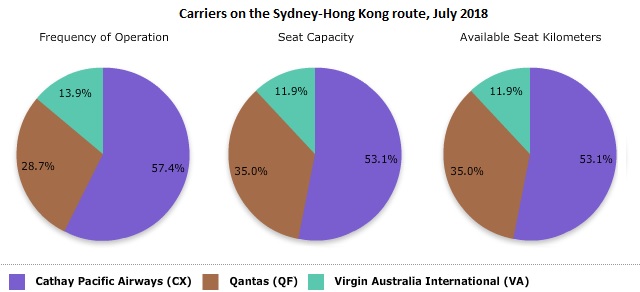Virgin Australia's entry onto the prime Sydney-Hong Kong route is likely to be a success thanks to capacity constraints, growing demand and a little help from its friends.
With the launch of its daily Airbus A330-200 services from 2 July, the carrier will join Cathay Pacific and Qantas on the route.
FlightGlobal schedules show that Cathay is the dominant carrier, operating four daily services with Boeing 777-300ERs and A330s, while Qantas flies twice daily with A330s and 747-400s.

FlightGlobal schedules via FlightMaps Analytics
The capacity growth has been following demand, and group executive Virgin Australia Airlines Rob Sharp tells FlightGlobal that its services will benefit from that.
"We are seeing growing demand from our customers for better access to Hong Kong and our new services between Sydney and Hong Kong will adequately address this," he says.
The launch of the flights comes nearly one year to the day since Virgin launched its Melbourne-Hong Kong services. Underpinned by an alliance with the HNA Group and its Hong Kong Airlines unit, the route has proven successful, increasing in frequency from four times a week at launch to daily from 12 November 2017.
Sharp adds that since Virgin launched on the route, fares have dropped by 30% as it broke the duopoly held by Qantas and Cathay Pacific.
But Hong Kong's slot constraints mean that the Melbourne-Hong Kong route will be reduced to five time a week, in order to allow Sydney-Hong Kong to launch as a daily service.
There is another Virgin link to the Hong Kong story, with Virgin Atlantic codesharing on Virgin Australia's Hong Kong flights. That will allow passengers to connect in Hong Kong onwards to London Heathrow, replacing a link that was lost in May 2014 when the UK carrier cut the Sydney tag on its Hong Kong flights.
CHINA FOCUS
Sharp says that Greater China is one of the two key pillars of Virgin's international strategy, with a focus on capturing "the growing Chinese tourism market, from both an inbound and outbound perspective", with its Hong Kong services.
Strong demand from tourists saw 1.4 million arrivals from China into Australia during the year ended February 2018. Canberra has forecast that the figure will grow to 3.9 million by 2025-27.
Aided by a 2015 open skies agreement between China and Australia, the number of routes between Australia and China has grown substantially. FlightGlobal schedules show that in the 12 months to July 2018, an additional 168 flights were added, delivering 12.7% more seats per month to the market.
While mainland China services are free of bilateral constraints, it is a different story for Hong Kong, which is covered by a separate air services agreement. For a number of years Cathay Pacific used all available entitlements on the Hong Kong side for access to Australia's gateway cities, effectively blocking competitors from entering the market.
Despite the proliferation of new nonstop services, Hong Kong is still seen as an important transit point for travellers to and from mainland China.
In that context, Virgin's alliance with 20% shareholder HNA Group and its affiliate Hong Kong Airlines is crucial to accessing that market. Similarly, with that carrier effectively blocked from accessing Australia's largest cities, it is reliant upon codesharing on Virgin's Sydney and Melbourne flights to access the Australian market.
That will become even more important from 28 October when Hong Kong Airlines ends its Hong Kong-Cairns-Gold Coast route. Launched as a charter service in April 2016, the route is one of few available to it as Cairns and the Gold Coast are not considered gateway cities under the Hong Kong-Australia bilateral.
While that may be something of a blow to the alliance, there have been some suggestions that it may actually be a net positive to Virgin, as it would allow Hong Kong Airlines to devote more of its marketing resources towards its partner's flights.
On top of the Hong Kong flights, Hong Kong Airlines also codeshares on a number of Virgin's domestic and transtasman services. Fellow HNA carrier Hainan Airlines also recently commenced a codeshare on Virgin's domestic network, which complements its own flights to Australia.
"Our alliance partnerships with Chinese carriers complements our Hong Kong offering by providing direct services from Australia to China, taking the number of Chinese destinations available for travel within our international network to 17," says Sharp.
LOOKING FURTHER?
Virgin Australia also holds rights to launch daily services to mainland China, but it has indicated previously that expanding into that market is on hold due to slot issues at major airports, such as Shanghai Pudong and Beijing Capital.
While Sharp says accessing the greater China market is a major priority, he will not be drawn on specifics about any further growth planned.
He says: "We are focussed on opportunities that will not only provide us with better accessibility to this market, but will allow us to establish a stronger foothold in this region. Our services to Hong Kong have definitely helped us to leverage our presence in this area of our international network."
Source: Cirium Dashboard






















